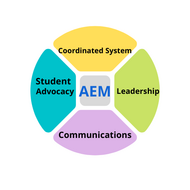Mada Accessibility & AT Glossary
(View Complete Item Description)Mada’s Glossary is the first dictionary of its kind, which includes terms related to ICT accessibility and assistive technology (AT) in the Arabic language. The Glossary was developed to serve as a vital resource for capacity building within ICT services, accessibility, and assistive technology in Qatar and beyond. Mada’s Glossary is essential to educate professionals, researchers, and individuals interested in the basic terms used in these fields. It is considered one of the first initiatives to provide such resources in Arabic.
Material Type: Reading


















